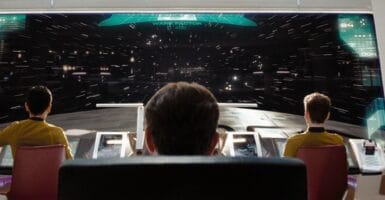A Year After The Last Shuttle Launch, NASA Promises A New Golden Age In Space Flight
This article is more than 2 years old
Believe it or not, it has been a year since shuttle Atlantis lifted off from Kennedy Space Center in Florida, marking the last flight of the program’s 31 year history and 135 launches. While the shuttle didn’t take us anyplace new, it was responsible for building the International Space Station and the launch and repair of one of the most well known NASA projects in the last several decades, the Hubble space telescope. NASA (and most notablyKennedySpaceCenter) doesn’t want you to think its best years are behind it though. They might not be building huge rockets these days, but they are definitely putting a lot of effort into maintaining their PR machine.
The retirement of the shuttles was announced by President Bush in as early as 2004 with the Constellation Program set to be its replacement, which in turn was woefully underfunded and has since been cancelled. The planned retirement was largely ignored by both the news and politicians until President Obama was elected in 2008 when the loss of the program became a political battleground between the elected officials whose districts live on money that the human spaceflight program provides (space pork) and others on both sides of the isle who just used it as talking point to illustrate how the other political party is killing America’s future, jobs, you name it, while still not offering NASA anything other than platitudes when it came time to decide on a budget. Meanwhile, NASA has its hands tied by an unrealistically low budget, high expectations, and an institutionalized “good ol boy” system that make any steps forward an exercise in futility. Add in a dash of low public confidence, and it’s enough to give the agency responsible for putting a man on the moon a serious complex, and not the type that you build space shuttles at.
The new video shows the facilities at KSC now being repurposed for a multitude of new vehicles. The Orbital Processing Facility 3 is being handed over to Boeing for their CST-100 development, while Lockheed Martin is getting an old Apollo-era building to house their Orion program and NASA’s colossal Vehicle Assembly Building is getting revamped to allow for the construction of many different rocket types for the first time. It is important to note that specific facilities like the one being used for Boeing’s CST-100 may become redundant once other similar vehicles prove more cost effective (SpaceX’s Dragon), more versatile (Lockheed Martin’s Orion), or for that matter just end up looking way more badass (Sierra Nevada’s Dreamchaser).
While having a wide variety of methods to get to space would be pretty cool, it just isn’t cost effective, so even though the promo video acts like Kennedy Space Center will turn into some bustling spaceport of the future ready to launch a myriad of vehicles into orbit, there still isn’t enough human traffic to space to justify having 4 or more different crew vehicles on the launch pad. So even though the development of the varying vehicles may be giving new life to KSC, look for some of those same buildings to become vacant once this new space race reaches its conclusion in the next 10 years or so.
Right now, all NASA can really do is make these videos to offer any proof that they are still working the problem on how to get America back into space on its own terms. Hopefully someday soon they’ll be able to switch from making PR videos to ones of Astronauts taking funny Facebook pics on the moon…












